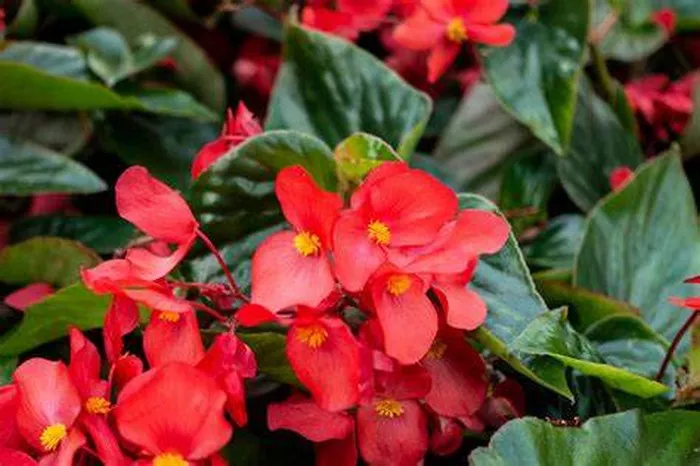Flowers, with their myriad colors, shapes, and fragrances, have enchanted humanity for centuries. Among the diverse botanical world, flowers that start with the letter “B” offer a rich tapestry of beauty and symbolism. From the iconic beauty of the rose to the delicate charm of the baby’s breath, each “B” flower possesses its own unique allure. In this comprehensive guide, we delve into the enchanting realm of flowers that proudly bear the initial “B.”
1. Begonia
Scientific Name: Begonia spp.
Overview: Begonias are beloved for their vibrant blooms and attractive foliage, making them a popular choice for gardens, containers, and indoor spaces. With over 1,800 species, this diverse genus offers a wide range of colors, shapes, and growth habits.
Appearance: Begonia flowers come in various shapes and sizes, ranging from small, delicate blooms to large, showy blossoms. They boast an array of colors, including shades of pink, red, orange, yellow, and white, often with intricate patterns or markings. Additionally, many begonia species feature striking foliage, adding to their ornamental appeal.
Growing Conditions: Begonias thrive in moist, well-drained soil and partial shade, although some species can tolerate full sunlight with adequate moisture. They are suitable for both indoor and outdoor cultivation, with many varieties flowering continuously throughout the growing season.
2. Bougainvillea
Scientific Name: Bougainvillea spp.
Overview: Bougainvilleas are renowned for their vibrant, bracts, which are often mistaken for flowers, surrounding small, inconspicuous blooms. Native to South America, these vigorous vines are prized for their stunning display of color and ability to thrive in warm, sunny climates.
Appearance: Bougainvillea bracts come in a range of colors, including shades of pink, red, purple, orange, and white, creating a dazzling spectacle when in full bloom. Their papery texture and vibrant hues make them a popular choice for adding color to fences, walls, and pergolas.
Growing Conditions: Bougainvilleas prefer well-drained soil and full sunlight, thriving in warm, tropical or subtropical climates. While they can withstand periods of drought, regular watering and occasional fertilization promote healthy growth and abundant flowering.
3. Bird of Paradise
Scientific Name: Strelitzia spp.
Overview: Bird of Paradise plants are revered for their striking resemblance to the tropical bird of the same name, with vibrant, bird-like blooms atop tall, sturdy stems. Native to South Africa, these exotic plants add a touch of tropical flair to gardens, landscapes, and indoor spaces.
Appearance: Bird of Paradise flowers feature distinctive orange and blue petals arranged in a fan-like shape, resembling the plumage of a bird in flight. Their bold colors and architectural form make them a focal point in any setting, whether planted in the ground or showcased in a container.
Growing Conditions: Bird of Paradise plants thrive in well-drained soil and full sunlight, although they can tolerate partial shade in hotter climates. Regular watering during the growing season and occasional fertilization promote healthy growth and prolific flowering.
4. Bluebell
Scientific Name: Hyacinthoides non-scripta
Overview: Bluebells, also known as wood hyacinths, are celebrated for their delicate, bell-shaped flowers and enchanting fragrance. Native to woodlands and meadows across Europe, these charming flowers herald the arrival of spring with their azure blooms.
Appearance: Bluebell flowers feature nodding, bell-shaped blooms in various shades of blue, ranging from pale sky blue to deep indigo. They grow in clusters atop slender stems, creating a carpet of color beneath deciduous trees and shrubs.
Growing Conditions: Bluebells thrive in moist, well-drained soil and partial shade, making them ideal for woodland gardens or naturalized areas. Planting bulbs in the fall allows for spring blooms, and they readily multiply over time, forming expansive drifts of flowers beneath the canopy.
5. Black-eyed Susan
Scientific Name: Rudbeckia hirta
Overview: Black-eyed Susans are prized for their cheerful blooms and resilience, making them a staple in gardens, meadows, and roadside plantings. Native to North America, these daisy-like flowers attract pollinators and add a vibrant splash of color to the landscape.
Appearance: Black-eyed Susan flowers feature golden-yellow petals surrounding a dark brown or black center, earning them their distinctive name. They bloom profusely from mid-summer to fall, providing a long-lasting source of nectar for bees, butterflies, and other pollinators.
Growing Conditions: Black-eyed Susans thrive in well-drained soil and full sunlight, although they can tolerate a wide range of soil types and light conditions. Regular deadheading promotes continuous flowering, while dividing clumps every few years helps maintain plant vigor and prevent overcrowding.
6. Bleeding Heart
Scientific Name: Lamprocapnos spectabilis (formerly Dicentra spectabilis)
Overview: Bleeding hearts are cherished for their unique heart-shaped blooms and graceful, arching stems. Native to Asia, these woodland perennials are prized for their romantic charm and delicate beauty.
Appearance: Bleeding heart flowers resemble tiny, dangling hearts in shades of pink, red, or white, dangling gracefully from arching stems. Their ethereal appearance and intricate form make them a favorite for shaded gardens, woodland borders, and cottage-style landscapes.
Growing Conditions: Bleeding hearts thrive in moist, well-drained soil and partial to full shade, making them ideal for shaded gardens or woodland settings. Mulching around the base of plants helps retain soil moisture and suppress weeds, while regular watering during dry spells promotes healthy growth and flowering.
Conclusion
From the vibrant blooms of begonias to the exotic allure of bird of paradise, flowers beginning with the letter “B” encompass a diverse array of colors, shapes, and characteristics. Whether adorning gardens, landscapes, or indoor spaces, these floral treasures captivate with their beauty and symbolism. By exploring the unique qualities of each “B” flower, gardeners and enthusiasts alike can gain a deeper appreciation for the wonders of the natural world and the boundless joy it brings.


